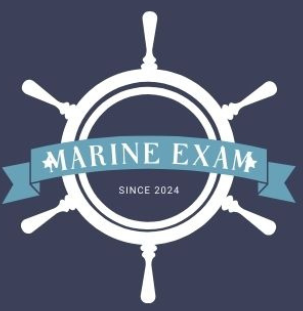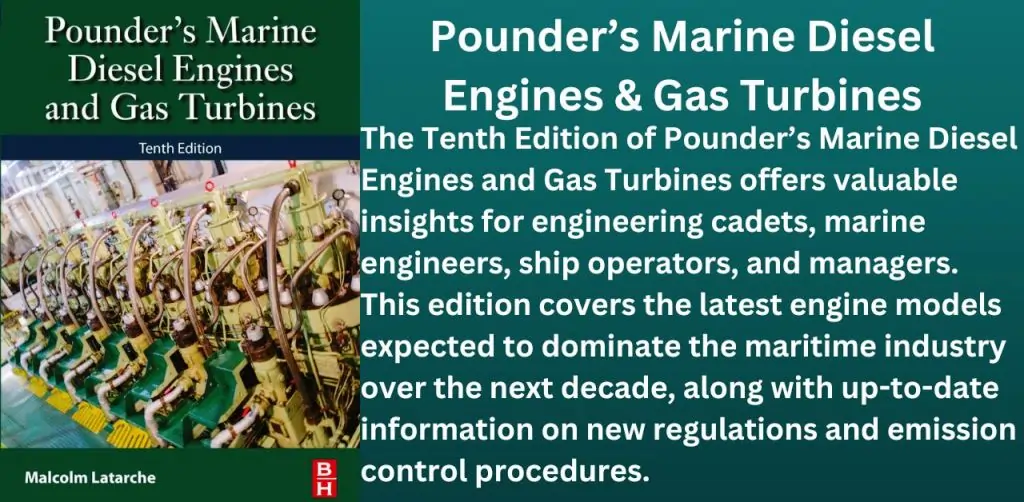Description
Book Title: Pounder’s Marine Diesel Engines & Gas Turbines
Author: Doug Woodyard
Overview
Pounders Marine Diesel Engines and Gas Turbines – Tenth Edition
The Tenth Edition of Pounder’s Marine Diesel Engines and Gas Turbines offers valuable insights for engineering cadets, marine engineers, ship operators, and managers. This edition covers the latest engine models expected to dominate the maritime industry over the next decade, along with up-to-date information on new regulations and emission control procedures.
Since the previous edition in 2009, the International Maritime Organization (IMO) has established several Emission Control Areas (ECAs), enforcing stricter limits on exhaust emissions. Additionally, new regulations now mandate measuring CO2 emissions based on cargo carried, significantly impacting new ship designs.
Key Features:
- Comprehensive Emission Control Technologies: Detailed coverage of Selective Catalytic Reduction (SCR) systems and water scrubbers for exhaust treatment.
- Updated Legislation: Complete revisions reflecting the latest emission standards and compliance procedures.
- Advanced Engine Monitoring: Expanded content on remote monitoring and control systems to enhance operational efficiency.
This edition is an essential resource for marine professionals aiming to stay updated on the evolving technologies and regulations shaping the future of marine propulsion systems
Key Takeaways
- In-depth exploration of marine diesel engines and gas turbines.
- New coverage on electronic-controlled fuel injection and emissions regulations.
- Essential for enhancing engine efficiency and reducing environmental impact.
Source of Availability
Pounder’s Marine Diesel Engines and Gas Turbines is available for purchase on Amazon.
Table of Contents
- Cover image
- Title page
- Table of Contents
- Copyright
- Preface
- Introduction
- Marine diesels—Powering ships for over a century
- Chapter One: International regulations
- Abstract
- Regulating NOx emissions
- Regulating SOx emissions
- Regulating other exhaust emissions
- Chapter Two: Theory and general principles
- Abstract
- Acknowledgements
- Theoretical heat cycle
- Practical cycles
- Efficiency
- Working cycles
- Horsepower
- Torque
- Mean piston speed
- Fuel consumption in 24H
- Vibration
- Balancing
- Noise
- Achieving quieter engine rooms
- Antivibration mountings
- Active mountings
- Low-speed engine vibration: Characteristics and cures
- First-order moments
- Second-order moments
- Axial vibrations
- Torsional vibrations
- Hull vibration
- Chapter Three: Dual-fuel and gas engines
- Abstract
- Wärtsilä 50DF engine
- MAN 51/60DF engine
- MAN Energy Solution’s ME-GI engine family
- VOC as a fuel supplement
- Design features of gas-burning engines
- Chapter Four: Exhaust emissions and control
- Abstract
- Acknowledgements
- Controlling NOx emissions
- Water-based NOx reduction techniques
- Selective catalytic reduction
- Particulates, soot, and smoke
- Chapter Five: Oil fuels chemistry and treatment
- Abstract
- Refinery processes
- Problems with heavy fuels
- Properties of fuel oil
- Fuel oil treatment
- Bunkering practice
- Chapter Six: Alternative fuels and treatment
- Abstract
- Alternative fuels and decarbonization
- Biofuels
- Methanol
- LNG
- Future fuels
- Chapter Seven: Lubes: Choices and testing
- Abstract
- Lubricating oils
- Cylinder lubricant feed rates
- Liner lacquering
- Lubricant testing
- Microbial contamination of fuels and lubricants
- Lube oil contamination
- Chapter Eight: Performance
- Abstract
- Maximum rating
- Exhaust temperatures
- Derating
- Multiple engine operating profiles
- Mean effective pressures
- Propeller slip
- Propeller law
- Fuel coefficient
- Admiralty constant
- Apparent propeller slip
- Propeller performance
- Power buildup
- Trailing and locking of propeller
- Astern running
- Chapter Nine: Engine and plant selection
- Abstract
- Diesel–mechanical drives
- Diesel–electric drive
- Chapter Ten: Turbocharging
- Abstract
- Turbocharging
- Turbocharger designers and manufacturers
- Turbocharger retrofits
- Turbo compound systems
- Turbocharger generator/motors
- Chapter Eleven: Fuel injection
- Abstract
- Acknowledgements
- Injection and combustion
- Injector
- Fuel line
- Pump
- Developments and trends
- Unit injector versus pump/pipe/injector
- Electronic fuel injection
- Common rail injection systems
- MTU common rail system for high-speed engines
- Wärtsilä CR system for medium-speed engines
- Chapter Twelve: Waste heat recovery
- Abstract
- Electricity from waste heat
- Chapter Thirteen: Low-speed two-stroke engines—Introduction
- Abstract
- Intelligent engines
- Chapter Fourteen: MAN B&W low-speed engines
- Abstract
- MC engine design features
- Programme expansion
- Large-bore engines
- Water mist catcher
- Electronically controlled ME engines
- Reduced fuel consumption
- Operational safety and flexibility
- Exhaust gas emissions flexibility
- Fuel injection system
- Exhaust valve actuation system
- Control system
- Cylinder pressure measuring system
- Starting air system
- ME engines in service
- Mark 9 and 10 large-bore engines
- Chapter Fifteen: Japan Engine Corporation low-speed engines
- Abstract
- UEC design details
- UEC eco-engine
- Emissions reduction
- UEC LSH series
- UEC LSJ series
- Cylinder lubrication
- Chapter Sixteen: WinGD (Wärtsilä/Sulzer) low-speed engines
- Abstract
- RTA series service and production
- RTA design features
- RTA design developments
- RT-flex electronic engines
- Generation X
- X92DF
- Chapter Seventeen: Legacy low-speed engines
- Abstract
- Burmeister & Wain (B&W)
- K-GF type engines
- L-GF and L-GB engines
- L-GBE type engines
- Sulzer RL-type engines
- Chapter Eighteen: Medium-speed engines—Introduction
- Abstract
- The four stroke engine
- Power extremes
- Power potential
- Chapter Nineteen: Anglo Belgian Corporation
- Abstract
- Chapter Twenty: Caterpillar
- Abstract
- 3600 series
- 3618 (bravo) engine
- C280 engine
- Chapter Twenty-One: MaK (Caterpillar Marine Power Systems)
- Abstract
- M32 engine
- M32C engine
- M43 engine
- M43C engine
- C-versions
- Dual-fuel DF-versions
- E-versions
- Low emissions technologies
- Common rail fuel system
- Earlier MAK models
- Chapter Twenty-Two: MAN Energy Solutions
- Abstract
- L58/64 engine
- 32/40 engine
- 48/60B engine
- L27/38 and L21/31 engines
- V28/33D engine
- Common rail engines
- Dual-fuel engines
- Chapter Twenty-Three: Rolls-Royce/MTU
- Abstract
- K-series
- B-series
- B32:40 engine
- B33:45 engine
- C-engine (C25:33L)
- Gas engines
- B36:45 gas engine
- Chapter Twenty-Four: Wärtsilä
- Abstract
- Wärtsilä Vasa 32
- Wärtsilä 32
- Wärtsilä 20
- Wärtsilä 26
- Wärtsilä 31
- Wärtsilä 38
- Wärtsilä 46
- Wärtsilä 64
- Wärtsilä dual-fuel engines
- Chapter Twenty-Five: Other medium-speed engines
- Abstract
- Daihatsu
- General Electric
- Grandi Motori Trieste
- HiMSEN (Hyundai Heavy Industries)
- Mirrlees Blackstone
- Mitsui
- Niigata
- Nohab
- SEMT-Pielstick
- SKL
- Stork-Werkspoor diesel
- Yanmar
- Two-stroke medium-speed engines
- Chapter Twenty-Six: High-speed engines
- Abstract
- Evolving a new design
- High-speed engine manufacturers
- Chapter Twenty-Seven: Gas turbines
- Abstract
- Acknowledgements
- Plant configurations
- Cycles and efficiency
- Emissions
- Lubrication
- Air filtration
- Marine gas turbine designs
- Gas turbine maintenance
- Chapter Twenty-Eight: Engine-room safety matters
- Abstract
- Acknowledgements
- Safety and training
- Fire safety
- Preventing crankcase explosions
- Crankcase explosions and relief valves
- Index
Conclusion
In today’s rapidly evolving maritime industry, staying updated with the latest technologies, regulations, and best practices is essential for marine engineers and industry professionals. Pounder’s Marine Diesel Engines and Gas Turbines, Tenth Edition, equips readers with the knowledge and tools needed to navigate these advancements, ensuring efficient, compliant, and sustainable ship operations. Whether you’re an engineering cadet or a seasoned marine engineer, this comprehensive guide is an invaluable resource for mastering modern marine propulsion systems and meeting the industry’s future demands.

